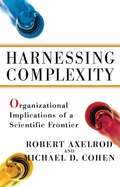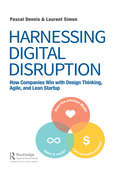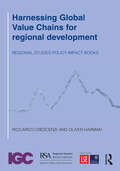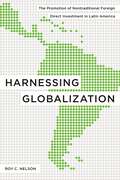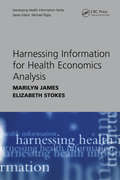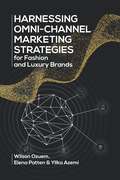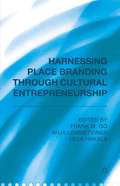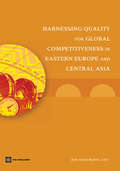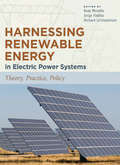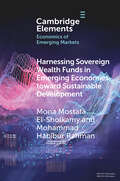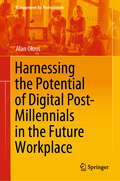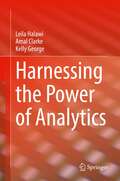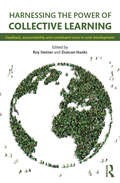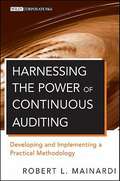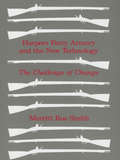- Table View
- List View
Harnessing Complexity
by Robert Axelrod Michael D CohenRecent advances in the study of complexity have given scientists profound new insights into how natural innovation occurs and how its power can be exploited. Now two pioneers in the field, Robert Axelrod and Michael D. Cohen, provide leaders in business and government with a guide to complexity that will help them make effective decisions in a world of rapid change. Building on evolutionary biology, computer science, and social design, Axelrod and Cohen have constructed a unique framework for improving the way people work together. Their approach to management is based on the concept of the Complex Adaptive System, which can describe everything from rain forests to the human gene pool, and from automated software agents to multinational companies. The authors' framework reveals three qualities that all kinds of managers must cultivate in their organization: Variation What is the best way to manage the development of software? Should the problem be broken up into small pieces for programmers working independently, thus enhancing variation, or should there be a centralized hierarchy of programmers ruled by a chain of command? The authors show how the decentralized creation of variation combined with the centralized maintenance of standards was the key to the success of the Linux "open source software" project, which brought together thousands of volunteers in cyberspace to produce an operating system that can outperform Microsoft's. Interaction Why did northern Italy prosper while southern Italy remained poor? Recognizing the internal interactions of a Complex Adaptive System -- be it a national region, a company, or a nonprofit group -- reveals vital networks of trust. Axelrod and Cohen explain that in successful adaptive systems, rich networks of horizontal linkages foster cooperation and provide an advantage over other less cooperatively networked groups. In the case of Italy, voluntary associations created networks of trust in the Middle Ages that became northern Italy's critical advantage over the south. Selection Is a Pulitzer Prize better than a National Book Award? How can foundations and corporations design competitions that have a positive effect on the evolution of excellence? The authors' framework makes clear that the worst selection processes are mired in orthodox standards that have not adapted to a new environment. The best selection processes, on the other hand, are created and run by leaders who understand how the standards they use can transform their organization and its environment. This simple, paradigm-shifting analysis of how people work together will transform the way we think about getting things done in a group. Harnessing Complexity is the essential guide to creating wealth, power, and knowledge in the 21st century.
Harnessing Digital Disruption: How Companies Win with Design Thinking, Agile, and Lean Startup (Ak Peters Visualization Ser.)
by Pascal Dennis Laurent SimonOur world has changed, probably for good. Until now, the shift from brick-and-mortar to the smartphone has been about service, cost, and convenience. Now, it's also a matter of public health. How do we win this uncertain new game? How do we prosper in a digital world? In a cool, readable style Harnessing Digital Disruption: How Companies Win with Design Thinking, Agile, and Lean Startup tells the story of a major multi-national organization facing digital disruption and looming irrelevance. In a compelling novel format, the book demonstrates how to harness the power of digital technology, methods and thinking on the path to revival and prosperity. It illustrates the situations, characters, and blockers you’ll likely face as you progress through your journey. The setting is Singapore and the heady world of international banking, but the prescription, methods and lessons apply equally to manufacturers, utilities, hospitals, insurers, and government agencies. You will learn how to:· Develop your Digital Transformation strategy and Innovation Portfolio· Reform customer journeys, launch new digital offerings, and validate new beta businesses· Develop senior leader digital literacy, and understanding of growth leadership· De-risk your journey using a proven overall approach based on proven principles· Cultivate a network of pragmatic entrepreneurs practicing a structured scalable innovation process This book offers clear and compelling guidance on what it takes to transform your organization for a digital world. Each chapter includes Study Questions to facilitate learning and discussion in workshop and classroom settings. .
Harnessing Foreign Investment to Promote Environmental Protection
by Jorge E. Viñuales Pierre-Marie DupuyHarnessing Foreign Investment to Promote Environmental Protection investigates the main challenges facing the implementation of environmental protection and the synergies between foreign investment and environmental protection. Adopting legal, economic and political perspectives, the contributing authors analyse the various incentives which encourage foreign investment into pro-environment projects (such as funds, project-finance, market mechanisms, payments-for-ecosystem services and insurance) and the safeguards against its potentially harmful effects (investment regulation, CSR and accountability mechanisms, contracts and codes of conduct).
Harnessing Global Value Chains for regional development: How to upgrade through regional policy, FDI and trade (Regional Studies Policy Impact Books)
by Riccardo Crescenzi Oliver HarmanThis Regional Studies Policy Impact Book brings together the latest academic evidence and public policy insights with global value chains (GVCs) and foreign direct investment (FDI). It comprises a comprehensive description and explanation of why they matter for regional development and policy. It focuses on how sub-national regions can leverage them for innovation and upgrading, or "levelling up". Specifically, its attention is on how regions can build, embed and reshape GVCs to their local enhancement. The book makes the case for proactive sub-national public policy, on the engagement of GVCs. Vertically engaging with FDI rather than setting the ground and letting manna drop from heaven. Its chosen approach is three-fold. First, it looks at why. Why GVCs and FDI matter and why sub-national policymakers should focus their attention on upgrading. It critically reviews different streams of research and evidence. This is in order to identify key definitions and conceptual foundations for the analysis of the link between GVCs, FDI and innovation at the sub-national and local level. Second, it looks at what. This is through new conceptualisations and critical insights on the regional drivers and impacts of global connectivity, bridging macro-international and micro-firm level approaches. Third, is the critical how. How policymakers can leverage GVCs and FDI for their regional benefit. It aims to review empirical evidence and available policy evaluation in order to highlight what works (and what does not) when leveraging these concepts to shape public policies with particular reference to less developed regions. If the above is of interest, then the book is for you. It is based on leading academic literature but uses non-technical language throughout making it engaging for policymakers, researchers and students alike.
Harnessing Globalization: The Promotion of Nontraditional Foreign Direct Investment in Latin America
by Roy C. NelsonHow can countries in the underdeveloped world position themselves to take best advantage of the positive economic benefits of globalization? One avenue to success is the harnessing of foreign direct investment (FDI) in the “nontraditional” forms of the high-technology and service sectors, where an educated workforce is essential and the spillover effects to other sectors are potentially very beneficial. In this book, Roy Nelson compares efforts in three Latin American countries—Brazil, Chile, and Costa Rica—to attract nontraditional FDI and analyzes the reasons for their relative success or failure. As a further comparison, he uses the successes of FDI promotion in Ireland and Singapore to help refine the analysis. His study shows that two factors, in particular, are critical. First is the government’s autonomy from special interest groups, both domestic and foreign, arising from the level of political security enjoyed by government leaders. The second factor is the government’s ability to learn about prospective investors and the inducements that are most important to them—what he calls “transnational learning capacity.” Nelson draws lessons from his analysis for how governments might develop more effective strategies for attracting nontraditional FDI.
Harnessing Information for Health Economics Analysis
by Marilyn James Elizabeth StokesSeries Editor: Michael Rigby This completely up-to-date resource equips readers with practical tools to understand and apply health economic methods. It introduces the key economic tools and the data available that can assist an economic decision and covers a range of areas from primary care and national data to global indicators of health. The information presented is applicable to all economic issues - at individual practice or nationwide policy level. Harnessing Information for Health Economics Analysis is a vital handbook for all clinicians, managers, and policy makers and shapers who make decisions about planning, commissioning and delivering healthcare. It will also be of great value to health economists, and postgraduate students in health economics and related disciplines.
Harnessing Omni-Channel Marketing Strategies for Fashion and Luxury Brands
by Wilson OzuemThis book provides a contemporary theoretical insight into the fashion and luxury industry, addressing potential gray areas within the literature. The authors analyze the luxury and fashion industry using multiple perspectives, allowing for a critical com
Harnessing Place Branding through Cultural Entrepreneurship
by Frank M. Go Arja Lemmetyinen Ulla HakalaThis book draws together three overlapping relationships and knowledge domains. These are the cultural entrepreneurship/creative industries, the public and/or private philanthropic contributions that have funded artistic production and the preservation and presentation of place brands as a mechanism to revitalize local economies and communities.
Harnessing Quality for Global Competitiveness in Eastern Europe and Central Asia
by Jean-Louis RacineStandards are everywhere, yet go mostly unnoticed. They define how products, processes, and people interact, assessing these entities' features and performance and signaling their level of quality and reliability. They can convey important benefits to trade, productivity, and technological progress and play an important role in the health and safety of individual consumers and the environment. Firms' ability to produce competitive products depends on the availability of adequate quality-support services. A "national quality infrastructure" denotes the chain of public and private services (standardization, metrology, inspection, testing, certification, and accreditation) needed to ascertain that products and services introduced in the marketplace meet defined requirements, whether demanded by authorities or by consumers. In much of Eastern Europe and Central Asia, national quality infrastructure systems are underdeveloped and not harmonized with those of their trading partners. This imbalance increases trade costs, hinders local firms' competitiveness, and weakens overall export performance. The objective of Harnessing Quality for Global Competitiveness in Eastern Europe and Central Asia is to highlight the need to reform and modernize the institutions in the region toward better quality and standards. The book ties in with much of the work done in the World Bank on the business environment, trade facilitation, economic diversification, and enterprise innovation. The countries in the region can improve this situation, revising mandatory standards, streamlining technical regulations, and harmonizing their national quality infrastructure with those of regional and international trade partners. Most governments will need to invest strategically in their national quality infrastructure, including pooling services with neighboring countries and stimulating local awareness and demand for quality. Specifically for the countries of the former Soviet Union, the restructuring process will need to improve governance, thus eliminating conflicts of interest and providing technically credible services to the economy.
Harnessing Renewable Energy in Electric Power Systems: Theory, Practice, Policy
by Richard Schmalensee Boaz Moselle Jorge PadillaReflecting its reliance on fossil fuels, the electric power industry produces the majority of the world's greenhouse gas emissions. The need for a revolution in the industry becomes further apparent given that 'decarbonization' means an increasing electrification of other sectors of the economy�in particular, through a switch from gasoline to electric vehicles. Of the options for producing electric power without significant greenhouse gas emissions, renewable energy is most attractive to policymakers, as it promises increased national self-reliance on energy supplies and the creation of new industries and jobs, without the safety and political concerns of nuclear power or the unproven technology of carbon capture and storage. Drawing on both economic theory and the experiences of the United States and EU member states, Harnessing Renewable Energy addresses the key questions surrounding renewable energy policies. How appropriate is the focus on renewable power as a primary tool for reducing greenhouse gas emissions? If renewable energy is given specific support, what form should that support take? What are the implications for power markets if renewable generation is widely adopted? Thorough and well-evidenced, this book will be of interest to a broad range of policymakers, the electric power industry, and economists who study energy and environmental issues.
Harnessing Sovereign Wealth Funds in Emerging Economies toward Sustainable Development (Elements in the Economics of Emerging Markets)
by Mona Mostafa El-Sholkamy Mohammad Habibur RahmanSovereign Wealth Funds are government investment vehicles that have been present for decades. They are usually characterized by minimum information disclosure, however, this situation differed after worldwide events shed light on the role they possess to mitigate their downturns. The substantial economic influence they bring along due to their size and long term impact have recently created an uproar of debate that eventually led to the ratification of the Santiago Principles. The Principles set the stage for governing SWFs' operations and grant them more clarity. They also contribute to a more stable environment for cross-border investment flows. With the importance of SWFs, emerging economies also rose as key institutional investors; only this time they called for harnessing their funds towards sustainable development investment strategies. Despite pressuring need to improve transparency and governance structures of SWFs in EMs, the former are regarded as promising means for achieving the sustainable development goals.
Harnessing the Potential of Digital Post-Millennials in the Future Workplace (Management for Professionals)
by Alan OkrosThis book offers strategic leaders with essential information for their most important role: the change management function of positioning the organization for success into the future. To do so, leaders need to sort through a myriad of forecasts, predictions and weak indicators of change to make timely decisions. This volume addresses the most critical factor for future success: people and, specifically, harnessing the potential the current youth cohort will bring when they join the full-time workforce. Drawing on multi-disciplinary analyses by 37 researchers, the book presents an integrative assessment of the characteristics that those in the current youth cohort are likely to bring to the workplace. The focus is on those born after 2005 with an examination of the implications of this cohort being raised from birth immersed in an increasingly omnipresent digital environment which extends far beyond social media. The authors see the coming ‘digital tsunami’ as creating disruptive effects across major elements of our economy and even society however optimistically conclude that the digital environment and the development of 21st Century skills in schools will equip the next generation with essential competencies, attitudes, social skills and work goals. The key to harnessing the potential of this generation will be to modify current human resources and workplace practices which will mean sweeping away much of the ‘boomer’ legacy that this cohort has imprinted on organizations. To assist leaders, the book goes beyond presenting a rich portrait of who these youth may become by providing practical recommendations for the changes that need to start now in order to position the organization to benefit from what they will bring. As the astute strategic leader knows: objects in the future can be closer than they appear.
Harnessing the Power of Analytics
by Leila Halawi Amal Clarke Kelly GeorgeThis text highlights the difference between analytics and data science, using predictive analytic techniques to analyze different historical data, including aviation data and concrete data, interpreting the predictive models, and highlighting the steps to deploy the models and the steps ahead. The book combines the conceptual perspective and a hands-on approach to predictive analytics using SAS VIYA, an analytic and data management platform. The authors use SAS VIYA to focus on analytics to solve problems, highlight how analytics is applied in the airline and business environment, and compare several different modeling techniques. They decipher complex algorithms to demonstrate how they can be applied and explained within improving decisions.
Harnessing the Power of Collective Learning: Feedback, accountability and constituent voice in rural development
by Roy Steiner Duncan HanksWhat were new ideas 30 years ago, such as the concepts of participatory development and systems thinking, are now accepted norms in international development circles. The majority of professionals engaged in rural development accept the proposition that the people who participate in development should play an active role in defining, implementing, and evaluating projects intended to improve their productivity and lives. However this goal remains unrealized in many development programs. Harnessing the Power of Collective Learning considers the challenges and potential of enabling collective learning in rural development initiatives. The book presents 11 case studies of organizations trying to develop and implement collective learning systems as an integral component of sustainable development practice. Through systematic reflection on action and experience, key lessons and themes emerge regarding the nature of voice, participation, feedback loops, accountability and transparency, that will be useful for many others in the development community. This book is a useful resource for academics, practitioners and policy makers in the areas of international development, sustainable development, organizational development, philanthropy, learning communities, monitoring and evaluation and rural development.
Harnessing the Power of Continuous Auditing
by Robert L. MainardiWritten to help auditors jump start their organization's near real-time financial data monitoring and sharing capabilities, Harnessing the Power of Continuous Auditing provides step-by-step instruction on how to build, market, implement, and manage a successful continuous auditing program.Taking concept to reality, author and internal audit expert Robert L. Mainardi presents auditors, company executives, business unit managers, practitioners, and consultants with a complete road map to continuous auditing, from start to finish. Beginning with a thorough definition of the subject, Mainardi debunks the various myths surrounding the process?including the most common misperception that the internal audit department must have the corresponding automated technology to support it?and includes numerous documented proven techniques and instructions for more effective SOX work.A vital tool to enhance the auditor's skills and abilities, Harnessing the Power of Continuous Auditing's exhaustive coverage includes: The definition of continuous auditing Where to begin Methodology development Preparing for continuous auditing Root cause analysis Action plans Problem-solving tools Lessons learned Selling continuous auditing Conditions and challenges This all-in-one handbook of practical execution provides much-needed, accessible guidance on everything business professionals need to know to conduct and implement a successful continuous audit in their organizations.
Harnischfeger Corp.
by Krishna G. PalepuPresents an analysis of Harnischfeger's quality of earnings, and the investment potential of the company's stock in light of the company's turnaround strategy.
Harold Mills at ZeroChaos (A)
by Lena G. Goldberg Maurice KuykendollAfter leading a management buy-out, Harold Mills transformed ZeroChaos into a global staffing enterprise. Poised to raise additional capital to fund the company's next phase of growth, he was also confronting the liquidity demands of his early-stage investors and relationships were becoming strained.
Harold Mills at ZeroChaos (B)
by Lena G. Goldberg Maurice KuykendollAfter leading a management buy-out, Harold Mills transformed ZeroChaos into a global staffing enterprise. Poised to raise additional capital to fund the company's next phase of growth, he was also confronting the liquidity demands of his early-stage investors and relationships were becoming strained.
Harper Chemical Co., Inc.
by E. Raymond CoreyA company acquires the rights to a mineral with potential uses in the ceramic and paint industries. After many years, sales are still far below expectations and the company considers selling the whole operation to a potential customer. Rewritten version of an earlier case.
Harpers Ferry Armory and the New Technology: The Challenge of Change
by Merritt Roe SmithFocusing on the day-to-day operations of the U.S. armory at Harpers Ferry, Virginia, from 1798 to 1861, this book shows what the "new technology" of mechanized production meant in terms of organization, management, and worker morale. A local study of much more than local significance, it highlights the major problems of technical innovation and social adaptation in antebellum America. Merritt Roe Smith describes how positions of authority at the armory were tied to a larger network of political and economic influence in the community; how these relationships, in turn, affected managerial behavior; and how local social conditions reinforced the reactions of decision makers. He also demonstrates how craft traditions and variant attitudes toward work vis-à-vis New England created an atmosphere in which the machine was held suspect and inventive activity was hampered. Of central importance is the author's analysis of the drastic differences between Harpers Ferry and its counterpart, the national armory at Springfield, Massachusetts, which played a pivotal role in the emergence of the new technology. The flow of technical information between the two armories, he shows, moved in one direction only-- north to south. "In the end," Smith concludes, "the stamina of local culture is paramount in explaining why the Harpers Ferry armory never really flourished as a center of technological innovation." Pointing up the complexities of industrial change, this account of the Harpers Ferry experience challenges the commonly held view that Americans have always been eagerly receptive to new technological advances.
Harrah's Entertainment, Inc.
by Rajiv Lal Patricia Martone CarroloDescribes a situation facing Philip Satre, chairman and CEO of Harrah's Entertainment, Inc. Satre was reading a May 2000 Wall Street Journal story that discussed the company's marketing success in targeting low rollers, the 100% growth in stock price and profits in the year to December 1999, and the revenue growth of 50%, which significantly outpaced the industry. The exciting articles aroused Satre's desire to know more about the activities of his then COO, Gary Loveman, and his team of "propeller heads" with respect to their database marketing efforts and the Total Reward Program. Satre was interested in two questions: He wanted to know how much these marketing efforts had contributed to Harrah's overall performance and whether these marketing results were a one-shot event or could be achieved year after year, especially as the competition introduced similar programs.
Harrah's Entertainment, Inc.: Rewarding Our People
by Thomas J. Delong Vineeta VijayaraghavanMarilyn Winn, head of human resources at Harrah's Entertainment, must make a recommendation to the company's president and CEO about whether the existing bonus payout program is effective at motivating employees or whether it should be revised and/or replaced. A recent downturn in economic conditions led Winn to wonder whether customer service payouts were the most efficient way to make Harrah's a service-driven and customer-driven company.
Harriman vs. Hill: Wall Street’s Great Railroad War
by Larry HaegIn 1901, the Northern Pacific was an unlikely prize: a twice-bankrupt construction of the federal government, it was a two-bit railroad (literally—five years back, its stock traded for twenty-five cents a share). But it was also a key to connecting eastern markets through Chicago to the rising West. Two titans of American railroads set their sights on it: James J. Hill, head of the Great Northern and largest individual shareholder of the Northern Pacific, and Edward Harriman, head of the Union Pacific and the Southern Pacific. The subsequent contest was unprecedented in the history of American enterprise, pitting not only Hill against Harriman but also Big Oil against Big Steel and J. P. Morgan against the Rockefellers, with a supporting cast of enough wealthy investors to fill the ballroom of the Waldorf Astoria. The story, told here in full for the first time, transports us to the New York Stock Exchange during the unfolding of the earliest modern-day stock market panic. Harriman vs. Hill re-creates the drama of four tumultuous days in May 1901, when the common stock of the Northern Pacific rocketed from one hundred ten dollars a share to one thousand in a mere seventeen hours of trading—the result of an inadvertent &“corner&” caused by the opposing forces. Panic followed and then, in short order, a calamity for the &“shorts,&” a compromise, the near-collapse of Wall Street brokerages and banks, the most precipitous decline ever in American stock values, and the fastest recovery. Larry Haeg brings to life the ensuing stalemate and truce, which led to the forming of a holding company, briefly the biggest railroad combine in American history, and the U.S. Supreme Court ruling against the deal, launching the reputation of Justice Oliver Wendell Holmes as the &“great dissenter&” and President Theodore Roosevelt as the &“trust buster.&” The forces of competition and combination, unfettered growth, government regulation, and corporate ambition—all the elements of American business at its best and worst—come into play in the account of this epic battle, whose effects echo through our economy to this day.
Harrington Collection: Sizing Up the Active-Wear Market
by Richard S. Tedlow Heather BeckhamIn the wake of slumping sales and sagging profit margins, a leading manufacturer and retailer of high-end women's apparel, Harrington Collection, must evaluate an opportunity to expand into the high-growth active-wear market. Sara Huey, Vice President of Strategic Planning, calls on two of her colleagues to help perform a comprehensive market evaluation. They must analyze the financial implications of the opportunity, assess trade and competitor reactions, consider the risks, and determine whether the Vigor division of the company will be able to successfully launch and manage the new product line.
Harrington Corp.
by Ronald W. MooreFour individuals purchase a small company, making heavy use of debt financing.
